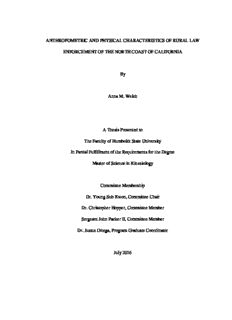
ANTHROPOMETRIC AND PHYSICAL CHARACTERISTICS OF RURAL LAW ENFORCEMENT OF PDF
Preview ANTHROPOMETRIC AND PHYSICAL CHARACTERISTICS OF RURAL LAW ENFORCEMENT OF
ANTHROPOMETRIC AND PHYSICAL CHARACTERISTICS OF RURAL LAW ENFORCEMENT OF THE NORTH COAST OF CALIFORNIA By Anna M. Welch A Thesis Presented to The Faculty of Humboldt State University In Partial Fulfillment of the Requirements for the Degree Master of Science in Kinesiology Committee Membership Dr. Young Sub Kwon, Committee Chair Dr. Christopher Hopper, Committee Member Sergeant John Packer II, Committee Member Dr. Justus Ortega, Program Graduate Coordinator July 2016 ABSTRACT ANTHROPOMETRIC AND PHYSICAL CHARACTERISTICS OF RURAL LAW ENFORCEMENT OF THE NORTH COAST OF CALIFORNIA Anna M Welch The geographical location of a rural police force produces unique challenges. Due to lack of backup, an officer or deputy may need to actively maintain control of a resisting suspect for as long as 30 minutes before backup arrives. Additionally, unlike urban and suburban regions of California, rural districts do not have a full-time special weapons and tactics team (SWAT) for immediate assistance. Therefore, patrol officers may need to maintain a perimeter for up to one and half hours until SWAT arrives. These expanded job-duties may increase their need to improve their physical fitness in order to efficiently perform their job duties. This was the first project of its kind to investigate all the health- and skill-related fitness components, including anaerobic capacity, and somatotyping on rural law enforcement officers. This project identified the physical characteristics of twelve male rural LEOs on the northern coast of California. Participants performed a battery of laboratory and field fitness tests, a Wingate Bike test, and thorough anthropometric assessments. Results were compared to general population age- and gender-based normative data, as well as to police normative data (Hoffman & Collingwood, 2015). Fitness testing revealed rural LEOs ranked at 45th percentile for cardiorespiratory fitness, 44th percentile for body composition, 65th percentile for strength, 53rd percentile for ii relative strength, 65th percentile for flexibility, and a higher ranking for power in the 76th percentile (Hoffman & Collingwood, 2015). Somatotyping results show dominant endomorphy characteristics, followed by relatively strong mesomorphy characteristics, categorizing rural LEOs as having a meso-endomorphic somatotype. iii ACKNOWLEDGEMENTS My deep gratitude goes first to my thesis project advisor, Dr. Kwon, who expertly guided and mentored me through my graduate education. His unwavering passion and relentless hard work kept me focused and motivated both personally and academically throughout the entirety of this project. Secondly, I want to express my appreciation towards the devoted law enforcement officers involved in this project who continue to bravely serve our community. Especially, Sgt. John Packer, who was an integral part of this project’s success. My appreciation extends also to my laboratory colleague, Gil Spitz, for his insight, and to my family including Dr. Ian Martin and Nichole McCune for their support and encouragement throughout this process. iv Table of Contents ABSTRACT ........................................................................................................................ ii ACKNOWLEDGEMENTS ............................................................................................... iv LIST OF TABLES ........................................................................................................... viii LIST OF FIGURES ........................................................................................................... ix INTRODUCTION .............................................................................................................. 1 REVIEW OF LITERATURE ............................................................................................. 5 Physical Characteristics of Law Enforcement Officers .................................................. 5 Literature Search ............................................................................................................. 6 Five Health-Related Fitness Components ....................................................................... 7 Body Composition. ..................................................................................................... 7 Cardiorespiratory fitness (CRF). ............................................................................... 11 Muscular Strength. .................................................................................................... 14 Muscular endurance. ................................................................................................. 19 Flexibility. ................................................................................................................. 21 Six Skill-Related Fitness Components ......................................................................... 23 Power. ....................................................................................................................... 23 Speed. ........................................................................................................................ 24 Agility, coordination, balance, and reaction time. .................................................... 25 Anaerobic Power and Capacity ..................................................................................... 27 Somatotyping ................................................................................................................ 28 v Background. .............................................................................................................. 28 Somatotyping in athletics. ......................................................................................... 31 Statement of the Problem .............................................................................................. 32 Purpose .......................................................................................................................... 33 Limitations .................................................................................................................... 33 Assumptions .................................................................................................................. 33 METHODS ....................................................................................................................... 34 Experimental Approach to the Problem ........................................................................ 34 Participants .................................................................................................................... 34 Procedures ..................................................................................................................... 34 Fitness testing. ........................................................................................................... 36 Sequence of testing. .................................................................................................. 37 Calculating somatotypes. .......................................................................................... 40 Statistical Analysis ........................................................................................................ 41 RESULTS ......................................................................................................................... 42 Health-Related Fitness Component Tests ..................................................................... 43 Body composition. .................................................................................................... 43 Cardiorespiratory Fitness. ......................................................................................... 43 Muscular Strength. .................................................................................................... 43 Muscular Endurance. ................................................................................................ 44 Flexibility. ................................................................................................................. 44 Skill-Related Fitness Component Tests ........................................................................ 44 Anaerobic Capacity ................................................................................................... 45 vi Somatotyping ............................................................................................................ 45 DISCUSSION ................................................................................................................... 46 Health-related Fitness Components .............................................................................. 46 Body composition. .................................................................................................... 46 Aerobic Capacity. ..................................................................................................... 47 Muscular Strength. .................................................................................................... 48 Muscular Endurance ................................................................................................. 49 Skill-Related Fitness Component Tests ........................................................................ 50 Anaerobic Power and Explosive Power. ................................................................... 50 Somatotyping. ........................................................................................................... 52 Practical Application ................................................................................................. 52 Implications and future studies ................................................................................. 54 REFERENCES ................................................................................................................. 72 vii LIST OF TABLES Table 1. Body Composition and Law Enforcement Officers ........................................... 56 Table 2. Cardiorespiratory Fitness and Law Enforcement Officers ................................. 58 Table 3. Muscular Strength and Law Enforcement Officers ............................................ 59 Table 4. Muscular Endurance and Law Enforcement Officers ......................................... 60 Table 5. Flexibility and Law Enforcement Officers ......................................................... 61 Table 6. Explosive Power and Law Enforcement Officers............................................... 61 Table 7. Speed and Law Enforcement Officers ................................................................ 62 Table 8. Coordination, Balance, Agility, Reaction Time and Law Enforcement Officers 62 Table 9. Somatotyping and Law Enforcement Officers ................................................... 63 Table 10. Descriptive Statistics for Demographics and Physical Characteristics of Rural LEOs ................................................................................................................................. 64 Table 11. Descriptive Statistics for Skill-Related Fitness of Rural LEOs ........................ 65 Table 12. Health- and Skill-Related Fitness Assessments of Rural LEOs ....................... 66 Table 13. Descriptive Statistics for Strength and Endurance of Leg Press ...................... 67 Table 14. Descriptive Statistics for Strength and Endurance for Bench Press ................. 68 Table 15. Descriptive Statistics for Strength and Endurance for Lat Pull-Down ............. 68 Table 16. Descriptive Statistics of Anaerobic Capacity ................................................... 69 viii LIST OF FIGURES Figure 1. Rural LEOs vs. Cooper Norms .......................................................................... 70 Figure 2. Rural LEOs: Meso-Endomorphic Somatotype .................................................. 71 Figure 3. Rural LEOs and Brazilian LEOs (Santos et al., 2007) Are Meso-Endomorphic ........................................................................................................................................... 71 ix LIST OF APPENDICES APPENDIX A: FIELD TESTS ......................................................................................... 85 APPENDIX B: INFORMED CONSENT ......................................................................... 86 x
Description: